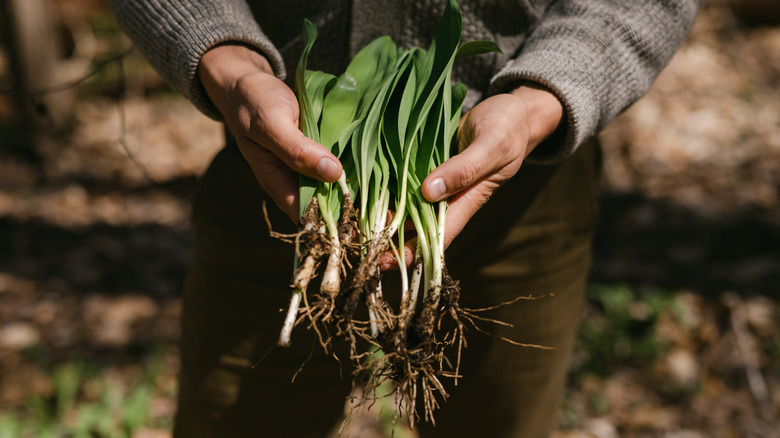A Spring Vegetable You Might Not Know About Can Prevent Cancer And Blood Clots At The Same Time
Eating fresh seasonal produce helps you learn more about the plants available in your area. It can help you better achieve your nutritional goals, too, as noted by registered dietitian nutritionist Annie Cavalier (via American Heart Association). Cavalier explains that "when you have those fruits and those vegetables that are richer in color, richer in flavor, that usually means that they're actually higher in nutrients as well." With that in mind, be open to looking beyond common spring veggies like artichokes, asparagus, and lettuce in the springtime. If you're fortunate, you may spy a forager's favorite called the wild ramp.
Cousin to alliums like leeks and garlic, the wild ramp isn't cultivated. It's a forest-loving food that appears early in the season and sticks around for just a few weeks. Consequently, you may only see it once or twice at a farmer's market stand that includes foraged foods. And if you do see some ramps for sale, be certain to buy some right away to support your healthy grocery shopping habits. They're frequently snatched up by foodies.
Why all the excitement over a garlicky, oniony plant that doesn't grow easily in gardens and is rather elusive? Wild ramps are an abundant source of anticancer compounds, as well as vitamin K and thiosulfinates. Consequently, adding wild ramps to your diet — even for a limited time — could assist you in creating a diet that lowers your risk of certain cancers and improves your body's blood clotting responses.
The cancer-preventing potential of wild ramps
Wild ramps contain sulfur compounds (e.g., allicin, thiosulfinates, and cepaenes) with anti-cancer potential. Studies suggest that consuming wild ramps may make it more difficult for some cancer cell lines to develop or grow. A 2025 article in Anticancer Research investigated the effect of organosulfur compounds on the reproduction of breast cancer cells. While it focused on the compounds in garlic, they are the same ones in all alliums, including wild ramps. The researchers concluded that those compounds could potentially inhibit breast cancer cell proliferation. (Read this for a comprehensive guide on breast cancer.)
Meanwhile, a 2001 paper in Environmental Health Perspectives clarifies the mechanism that may give organosulfur compounds in allium plants (like wild ramps) their protective abilities. It's possible that the compounds block the creation of cancer cells in certain areas of the body, including those involving the breasts, lungs, and gastrointestinal organs. Lastly, a 2024 review in Nutrients noted that organosulfur compounds had proven to be effective against colorectal cancer cell development in several trials.
Wild ramps can keep blood clotting at a healthy level
The vitamin K and thiosulfinates in wild ramps act in two distinctive ways that both involve blood clotting.
Vitamin K plays a role in blood clotting, a process that encourages platelets and proteins to come together when the blood vessels are damaged. For example, when you get a cut on your finger, your blood tends to thicken (clot) to slow blood loss. If your blood didn't clot, you would be at risk of dying from even small wounds. Wild ramps are relatives of leeks, and for every leek you consume, you can expect to get about 31 micrograms of vitamin K. That's not bad, given that the daily recommended dose of vitamin K for women and men is 90 and 120 micrograms, respectively.
On the other hand, thiosulfinates act on your blood by inhibiting clotting. In a sense, thiosulfinates are natural blood thinners, which may be important if you're working with your doctor to naturally reduce your blood pressure and treat unwanted blood clots. But you may want to avoid extensively cooking your wild ramps if you're trying to maximize their blood thinning effect. A 2007 study from the Journal of Agricultural and Food Chemistry showed that when garlic was cooked for at least 10 minutes, its antiplatelet properties vanished. Since wild ramps and garlic are both alliums, wild ramps may exhibit similar properties.


